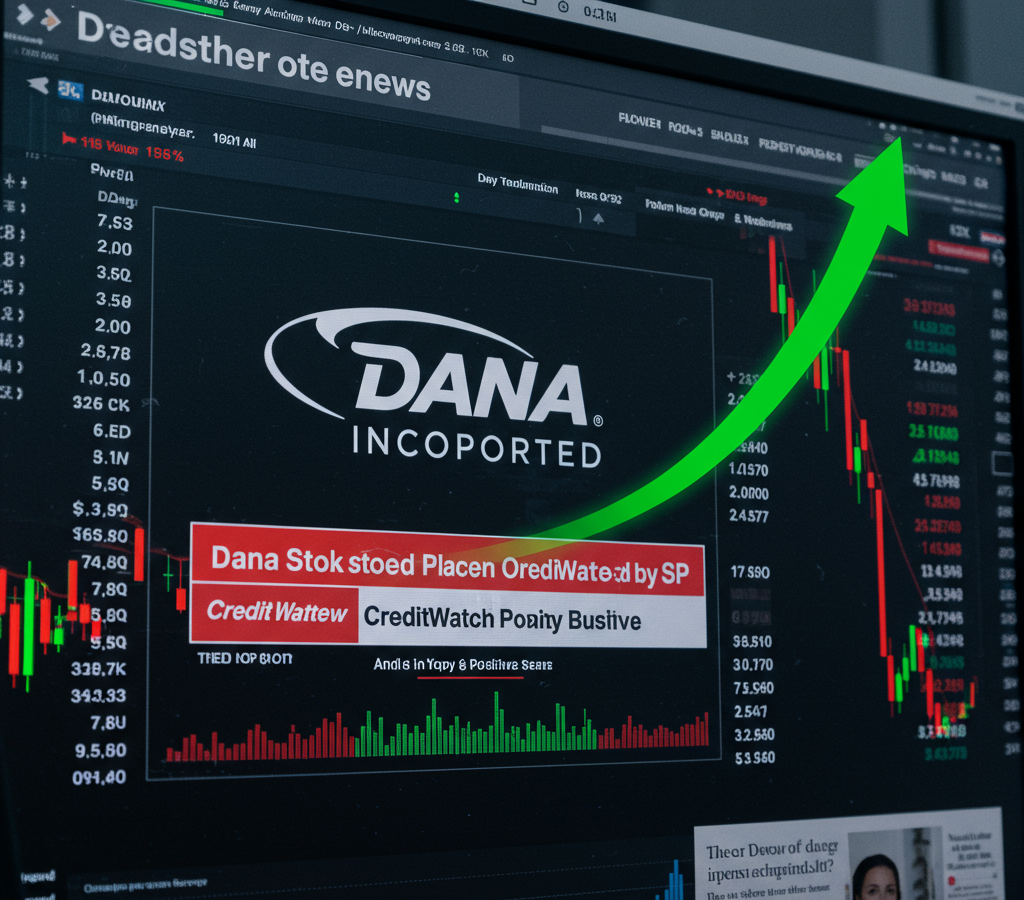Dana’s Stock Outlook Brightens with Major Business Sale: Here’s What Investors Should Know
When a company makes big moves, the stock market pays attention. That’s exactly what’s happening with Dana Incorporated right now. Recently, Dana made headlines with a key decision to sell off part of its business—and credit agency S&P took notice. Investors are understandably curious: what does this mean for Dana’s future and stock performance?
Let’s break it down in simple terms. Whether you’re a seasoned investor or just getting started, this move could signal interesting things ahead for the company—and your portfolio.
What’s the Big News About Dana?
Dana Incorporated, a global leader in drivetrain and e-propulsion systems (basically, things that power vehicles), just sold off its Off-Highway European and South American businesses.
Now, this might sound like technical financial talk—but here’s why it matters: S&P Global Ratings responded by putting Dana’s stock on “CreditWatch Positive.” Translation? Dana’s credit rating might go up soon, which is seen as great news by investors and the financial community.
Why Selling Off Part of a Business Could Be Smart
At first glance, letting go of a piece of your business might seem risky. But here’s the logic behind it. Dana is trimming back to focus on its core operations—the areas it does best in. With electric vehicles and modern driveline systems gaining momentum, Dana wants to lead that charge. Selling its off-highway operations (which mostly dealt with older, traditional vehicle platforms) helps sharpen its focus and potentially boost long-term profitability.
Think of it like cleaning out your garage: by letting go of what no longer serves you, you make room for something new and better.
What S&P’s CreditWatch Means (In Plain English)
You’ve probably heard of companies having credit ratings, much like individuals have credit scores. S&P is one of the giant firms that provide those ratings. When they put Dana on “CreditWatch Positive,” they’re basically signaling, “Hey, we’re thinking about raising your score soon.”
And why does that matter? Because higher ratings make it easier and cheaper for a company to borrow money. Lower borrowing costs can lead to more investments in research, better facilities, and possibly more profit in the long run.
A Quick Snapshot of Dana’s Big Move
Here’s a simple table that captures the major highlights of the deal and its possible impact:
| Key Event | Details |
|---|---|
| Business Sold | European & South American Off-Highway Operations |
| Buyer | Komatsu, a global construction equipment leader |
| Strategic Goal | Focus on high-growth areas like electric vehicle technologies |
| S&P’s Reaction | Put Dana on CreditWatch Positive |
| Potential Outcome | Improved credit rating, lower debt costs, potential stock boost |
So What’s Next for Dana?
If the sale closes successfully and Dana redirects its focus and resources as planned, chances are good that the company could become leaner, more efficient, and more profitable. The improved cash flow from the sale, along with fewer financial obligations tied to the off-highway operations, might put Dana in a stronger position to grow.
And don’t forget—credit rating upgrades often lead to renewed investor confidence. That can boost stock prices, making shareholders happy.
Keyword Spotlight: What Investors Should Monitor
If you’re investing in auto tech or industrial stocks, here are a few keywords and themes to watch moving forward:
- Electrification of vehicles – Dana’s pushing into EV drivetrains
- Debt reduction – This sale aids Dana in deleveraging
- Credit rating upgrade – More than just financial talk; it affects lenders and shareholders
- Business realignment – Selling to sharpen focus is strategic, not desperate
- Investor sentiment – Market reactions often follow big agency recommendations
What Does This Mean for You?
Let’s say you’re an investor who owns shares of Dana or one who’s curious about the industrial and electric vehicle sectors. This news could be a cue to keep a closer eye on Dana’s performance in the coming months. A potential credit upgrade, increased focus on high-growth markets like electrification, and stronger cash reserves could all contribute to above-market returns.
But as always, no investment is without risks. It’s worth paying attention to how successfully Dana reinvests the proceeds of the sale and whether it continues to innovate in the EV space.
Real-Life Analogy: Think of Dana Like a Startup Trimming the Fat
Imagine you run a small business. You’re great at making artisanal coffee, but for years you’ve also tried to run a smoothie bar on the side. It never really took off. After a while, you decide to let someone else take over the smoothie bar and double down on your coffee game. You upgrade your machines, hire better baristas, and launch a signature roast. Soon, more customers show up—and your profits climb.
That’s what Dana is doing here. By letting go of a side operation, Dana is getting back to what it does best—only with a high-tech twist.
Conclusion: This Could Be a Turning Point
Dana’s recent sale isn’t just a routine business deal. It’s a signal that the company is serious about evolving with the industry, which is moving rapidly toward electrification and efficient drivetrains. With S&P eyeing a potential rating upgrade, Dana seems poised to gain more financial flexibility and competitive edge.
If you’re following the industrials or looking at potential EV sector investments, Dana might be worth a deeper look. Just like pruning a tree helps it grow stronger, Dana’s strategic cut might help it thrive in the years ahead.
Final Thought: Keep Your Investment Radar On
Markets can be complex, but shifts like these offer valuable cues. Pay attention to how Dana reinvests and whether analysts continue to feel optimistic. Whether you’re holding shares or just exploring, staying informed and curious is always a smart investor’s move.
Who knows? This just might be Dana’s moment to shine.
